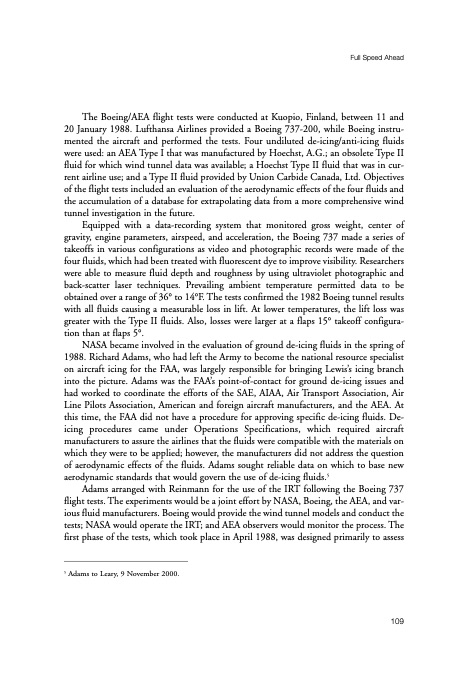
PDF Publication Title:
Text from PDF Page: 121
The Boeing/AEA flight tests were conducted at Kuopio, Finland, between 11 and 20 January 1988. Lufthansa Airlines provided a Boeing 737-200, while Boeing instru- mented the aircraft and performed the tests. Four undiluted de-icing/anti-icing fluids were used: an AEA Type I that was manufactured by Hoechst, A.G.; an obsolete Type II fluid for which wind tunnel data was available; a Hoechst Type II fluid that was in cur- rent airline use; and a Type II fluid provided by Union Carbide Canada, Ltd. Objectives of the flight tests included an evaluation of the aerodynamic effects of the four fluids and the accumulation of a database for extrapolating data from a more comprehensive wind tunnel investigation in the future. Equipped with a data-recording system that monitored gross weight, center of gravity, engine parameters, airspeed, and acceleration, the Boeing 737 made a series of takeoffs in various configurations as video and photographic records were made of the four fluids, which had been treated with fluorescent dye to improve visibility. Researchers were able to measure fluid depth and roughness by using ultraviolet photographic and back-scatter laser techniques. Prevailing ambient temperature permitted data to be obtained over a range of 36° to 14°F. The tests confirmed the 1982 Boeing tunnel results with all fluids causing a measurable loss in lift. At lower temperatures, the lift loss was greater with the Type II fluids. Also, losses were larger at a flaps 15° takeoff configura- tion than at flaps 5°. NASA became involved in the evaluation of ground de-icing fluids in the spring of 1988. Richard Adams, who had left the Army to become the national resource specialist on aircraft icing for the FAA, was largely responsible for bringing Lewis’s icing branch into the picture. Adams was the FAA’s point-of-contact for ground de-icing issues and had worked to coordinate the efforts of the SAE, AIAA, Air Transport Association, Air Line Pilots Association, American and foreign aircraft manufacturers, and the AEA. At this time, the FAA did not have a procedure for approving specific de-icing fluids. De- icing procedures came under Operations Specifications, which required aircraft manufacturers to assure the airlines that the fluids were compatible with the materials on which they were to be applied; however, the manufacturers did not address the question of aerodynamic effects of the fluids. Adams sought reliable data on which to base new aerodynamic standards that would govern the use of de-icing fluids.5 Adams arranged with Reinmann for the use of the IRT following the Boeing 737 flight tests. The experiments would be a joint effort by NASA, Boeing, the AEA, and var- ious fluid manufacturers. Boeing would provide the wind tunnel models and conduct the tests; NASA would operate the IRT; and AEA observers would monitor the process. The first phase of the tests, which took place in April 1988, was designed primarily to assess Full Speed Ahead 5 Adams to Leary, 9 November 2000. 109PDF Image | History of NASA Icing Research Tunnel

PDF Search Title:
History of NASA Icing Research TunnelOriginal File Name Searched:
sp4226.pdfDIY PDF Search: Google It | Yahoo | Bing
NFT (Non Fungible Token): Buy our tech, design, development or system NFT and become part of our tech NFT network... More Info
IT XR Project Redstone NFT Available for Sale: NFT for high tech turbine design with one part 3D printed counter-rotating energy turbine. Be part of the future with this NFT. Can be bought and sold but only one design NFT exists. Royalties go to the developer (Infinity) to keep enhancing design and applications... More Info
Infinity Turbine IT XR Project Redstone Design: NFT for sale... NFT for high tech turbine design with one part 3D printed counter-rotating energy turbine. Includes all rights to this turbine design, including license for Fluid Handling Block I and II for the turbine assembly and housing. The NFT includes the blueprints (cad/cam), revenue streams, and all future development of the IT XR Project Redstone... More Info
Infinity Turbine ROT Radial Outflow Turbine 24 Design and Worldwide Rights: NFT for sale... NFT for the ROT 24 energy turbine. Be part of the future with this NFT. This design can be bought and sold but only one design NFT exists. You may manufacture the unit, or get the revenues from its sale from Infinity Turbine. Royalties go to the developer (Infinity) to keep enhancing design and applications... More Info
Infinity Supercritical CO2 10 Liter Extractor Design and Worldwide Rights: The Infinity Supercritical 10L CO2 extractor is for botanical oil extraction, which is rich in terpenes and can produce shelf ready full spectrum oil. With over 5 years of development, this industry leader mature extractor machine has been sold since 2015 and is part of many profitable businesses. The process can also be used for electrowinning, e-waste recycling, and lithium battery recycling, gold mining electronic wastes, precious metals. CO2 can also be used in a reverse fuel cell with nafion to make a gas-to-liquids fuel, such as methanol, ethanol and butanol or ethylene. Supercritical CO2 has also been used for treating nafion to make it more effective catalyst. This NFT is for the purchase of worldwide rights which includes the design. More Info
NFT (Non Fungible Token): Buy our tech, design, development or system NFT and become part of our tech NFT network... More Info
Infinity Turbine Products: Special for this month, any plans are $10,000 for complete Cad/Cam blueprints. License is for one build. Try before you buy a production license. May pay by Bitcoin or other Crypto. Products Page... More Info
| CONTACT TEL: 608-238-6001 Email: greg@infinityturbine.com | RSS | AMP |